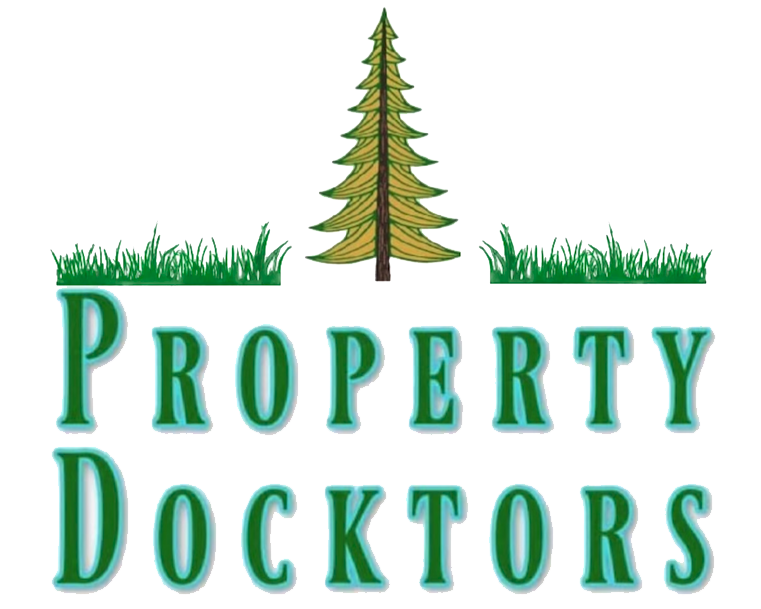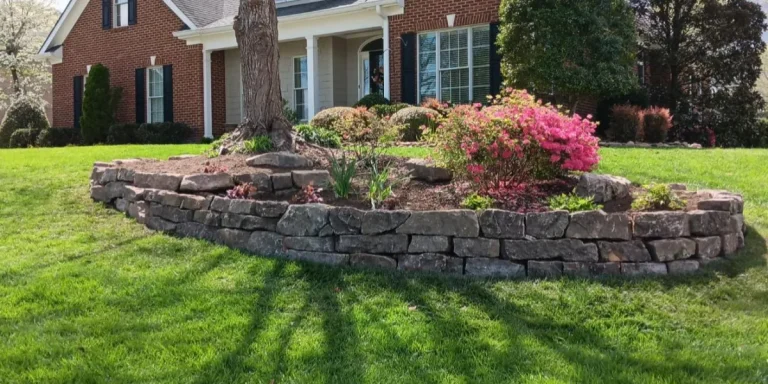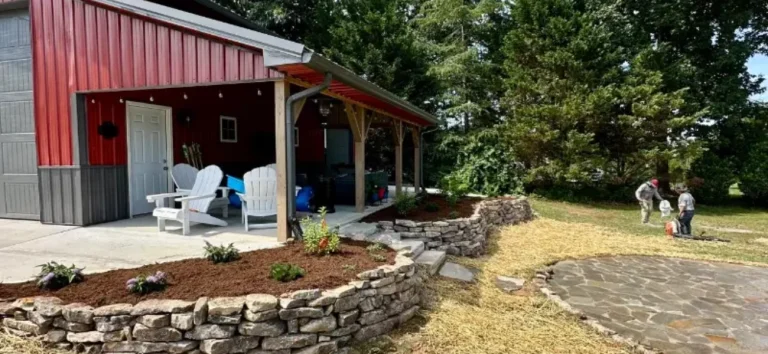The Role of Geo-Grid Reinforcement in Tall Retaining Walls

Retaining walls are critical for managing slopes, preventing erosion, and creating level space in your landscape—but the taller they get, the more engineering they require. One of the most important components in building tall, long-lasting retaining walls is something many homeowners have never heard of: geo-grid reinforcement.
At Property Docktors Landscaping, we use geo-grid systems in our structural retaining wall projects across Lenoir City, Loudon, and surrounding East Tennessee communities to ensure safety, stability, and long-term performance. In this post, we’ll explain what geo-grid is, how it works, and why it’s essential for retaining walls over a certain height.
What is geo-grid reinforcement?
Geo-grid is a high-strength, synthetic mesh material—usually made from polyester, polypropylene, or fiberglass—that is laid between layers of retaining wall blocks and extended deep into the soil behind the wall. Its job is to provide tensile reinforcement, helping the wall resist pressure from the soil and water behind it.
Think of it as an “anchor” that ties the wall and the hillside together, distributing pressure more evenly and significantly reducing the risk of wall failure.
Why geo-grid is essential for tall retaining walls
The taller a retaining wall gets, the more pressure it must withstand. While short garden walls may hold back minimal soil, tall retaining walls bear a tremendous amount of lateral force—not just from the weight of the soil itself, but from added stress caused by rainwater saturation, shifting ground, freeze-thaw cycles, and slope conditions.
As height increases, so does the risk of structural failure—especially if the wall lacks internal support. That’s where geo-grid reinforcement becomes critical.
The challenges of building taller walls
When a wall exceeds 4 feet in height, the following issues become more likely:
-
- Increased soil pressure
Heavier soil loads exert force directly against the wall, particularly in wet or compacted conditions. - Hydrostatic pressure buildup
Without proper reinforcement and drainage, water accumulating behind the wall adds thousands of pounds of outward force. - Soil instability and movement
Properties with clay-heavy soils or steep terrain—common in Lenoir City, Loudon, and Maryville—are prone to shifting and settling that puts added strain on the structure. - Stress fractures and material fatigue
Over time, small cracks can develop and widen under pressure, leading to premature failure.
- Increased soil pressure
How geo-grid reinforcement solves these problems
Geo-grid works by tying the retaining wall into the soil it holds back. Instead of the wall resisting all the pressure on its own, the geo-grid spreads that load across a much wider area. This reduces the strain on the wall face and helps the entire system act as one integrated, stable structure.
The result is:
-
- A wall that remains plumb and secure, even at greater heights
- Improved resistance to movement, settlement, and deformation
- The ability to build taller walls safely and confidently, without relying solely on weight or bulk
- Better performance in high-moisture, freeze-prone, and slope-heavy environments
In other words, geo-grid reinforcement isn’t just a structural add-on—it’s a necessary part of the design for any tall retaining wall that needs to withstand the environmental challenges common to East Tennessee landscapes.
How geo-grid is installed in a retaining wall
At Property Docktors Landscaping, we don’t cut corners when it comes to structural integrity. That’s why we follow strict manufacturer specifications and proven engineering practices when installing geo-grid reinforcement. Every retaining wall we build—especially those over four feet in height—is carefully constructed to ensure long-term performance, safety, and durability.
Here’s a clear breakdown of our step-by-step process when incorporating geo-grid reinforcement into a retaining wall system:
1. Excavation and site preparation
-
- We begin by excavating both the footprint of the wall and the area behind it. This ensures there is enough space for gravel backfill, geo-grid layers, and drainage systems.
- The ground is graded and compacted to create a stable base for both the wall and the reinforced soil behind it.
2. Base installation and the first course of blocks
-
- A solid, level base is essential for the success of any retaining wall.
- We install a compacted gravel base—usually 6 to 12 inches deep—to support the bottom course of blocks.
- The first few rows of wall blocks are installed with precision, forming the structural foundation of the wall.
3. Installing the first layer of geo-grid
-
- Once the base blocks are set, we roll out the first layer of geo-grid perpendicular to the wall face, extending it back into the slope.
- The length of the grid typically matches 60% to 100% of the wall height, depending on soil conditions and load requirements.
- We cut the geo-grid to fit the width of the wall and stake it securely in place.
4. Backfilling and compacting
-
- Clean, angular crushed stone or gravel is placed over the geo-grid layer in 8- to 12-inch lifts, then compacted using vibratory equipment.
- Proper compaction is critical—it eliminates air pockets and ensures that the geo-grid remains tensioned and effective.
5. Layering and repeating the process
-
- We continue building the wall in courses, repeating the process:
-
- Add more wall blocks
- Insert another layer of geo-grid
- Backfill and compact
-
- The spacing and number of geo-grid layers depend on the total wall height and the soil’s load-bearing characteristics. For taller or load-bearing walls, more frequent reinforcement may be required—every 2 or 3 rows of blocks.
- We continue building the wall in courses, repeating the process:
6. Final wall construction and drainage integration
-
- Once the wall reaches the desired height, we complete it with cap stones and install a full drainage system, which typically includes:
-
- A perforated drain pipe (French drain)
- Filter fabric
- Weep holes or drainage outlets
-
- These features help relieve hydrostatic pressure behind the wall and ensure water drains efficiently—preventing the buildup that causes most retaining wall failures.
- Once the wall reaches the desired height, we complete it with cap stones and install a full drainage system, which typically includes:
Our process isn’t just about meeting minimum standards—it’s about exceeding them. By using geo-grid reinforcement and precision installation techniques, we give our clients in Lenoir City, Farragut, Maryville, and nearby areas retaining walls that don’t just look great, but stand the test of time.
A local example: Stabilizing a steep backyard in Farragut, TN
One recent project involved building a 6-foot retaining wall for a homeowner in Farragut, where the backyard sharply sloped toward the house. Without reinforcement, the wall would have been vulnerable to soil movement and water pressure.
We installed two layers of geo-grid and integrated a full drainage system behind the wall, including gravel backfill and a French drain. The result was a clean, solid wall that not only leveled the yard but will remain structurally sound for decades.
When should you use geo-grid in your retaining wall project?
Not every retaining wall requires geo-grid reinforcement—but when it’s needed, it’s not optional. Geo-grid is a critical structural element that can mean the difference between a wall that holds strong for decades and one that starts to lean, crack, or fail prematurely.
If your retaining wall meets any of the following conditions, geo-grid should absolutely be part of the design—and in many cases, it’s required by building codes or manufacturer specifications.
Geo-grid is essential when:
-
- The wall is over 4 feet tall
Most structural walls taller than 4 feet need geo-grid to handle the increased pressure from soil and water behind them. Building a tall wall without reinforcement is a major risk, especially in regions with heavy seasonal rainfall like East Tennessee. - Your property has steep slopes or poor soil conditions
Sloped landscapes create more lateral pressure, and unstable soils (such as expansive clay or loosely compacted fill) provide little resistance. Geo-grid helps lock the soil and wall together, increasing overall stability. - The wall must support a driveway, patio, or structure
When a retaining wall is holding back soil beneath a heavy surface—like a vehicle parking area, outdoor kitchen, or stone patio—the structural demands increase significantly. Geo-grid reinforcement helps distribute these extra loads across a wider area. - You’ve had issues with previous wall failures or drainage
If an older wall on your property has already failed, chances are it lacked proper reinforcement and water management. A replacement wall with geo-grid and integrated drainage will give you a long-term fix, not a temporary patch. - You want a retaining wall that lasts 25+ years with minimal maintenance
Property owners who plan to stay in their home—or want to maximize resale value—should invest in the kind of construction that lasts. A geo-grid-reinforced wall is built not just for today, but for the next generation.
- The wall is over 4 feet tall
If you're unsure whether your project requires geo-grid, it's best to consult with a qualified professional. At Property Docktors Landscaping, we assess every project site individually to determine whether reinforcement is necessary—and if so, how many layers, what spacing, and what type of grid will provide the best results.
Proudly serving East Tennessee with engineered retaining wall solutions
Property Docktors Landscaping provides expert retaining wall installation—including geo-grid reinforcement—throughout:
-
- Lenoir City
- Loudon
- Farragut
- Oak Ridge
- Maryville
- Kingston
- Tellico Village
- And nearby East Tennessee communities
Build it right the first time—contact us today
Need a tall retaining wall that’s safe, strong, and built to last?
Don’t take chances with unreinforced walls. Contact Property Docktors Landscaping for a professional consultation and estimate. We specialize in structural retaining wall construction, drainage systems, and erosion control tailored to East Tennessee properties.
Call today or request an estimate online to get started. We proudly serve Lenoir City, Loudon, Farragut, Maryville, and surrounding areas.



